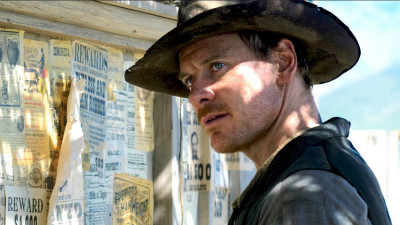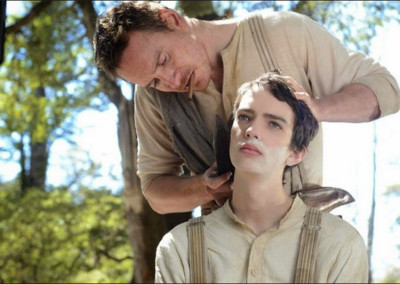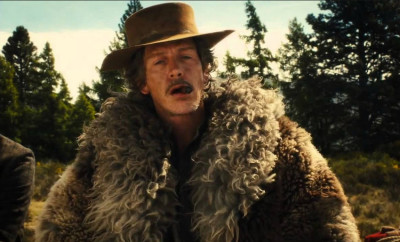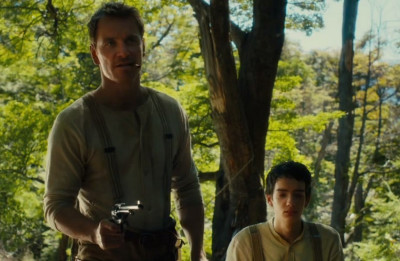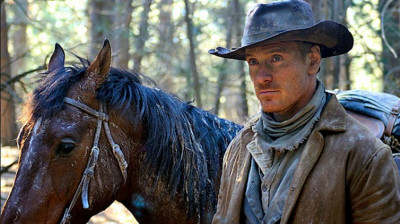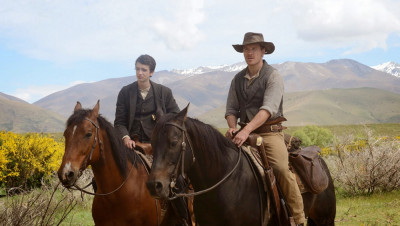Michael Fassbender. In a Western. And a scene in which we see the “Fabulous Fassy” in a wet, clinging, white union suit. Do I have your attention ladies? Well, that’s just one image you can expect in John Maclean’s SLOW WEST. Other images include breathtaking cinematography from Robbie Ryan showcasing the beauty and depth of 1870’s Colorado (for which New Zealand serves as a perfect doppleganging substitute), lensed with the early widescreen format – 1.66:1- which audiences first saw with Paramount’s “Shane” in 1953, not to mention a meticulously crafted story with indelible performances from the likes of Kodi Smit-McPhee, Ben Mendelsohn and Caren Pistorius. One look at SLOW WEST and one is transported back in time, immersed in cinematic beauty and scope, and loving every second of it.
As the puppy dog eyed young Scotsman, Jay Cavendish, Kodi Smit-McPhee seamlessly makes the transition into more adult roles and goes toe-to-toe with Michael Fassbender. Cavendish is in love with the lovely Scottish lass, Rose Ross, who together with her father, is on the run and heads to the American West to start a new life. Determined to spend his life with Rose, unbeknownst to her, the wide-eyed innocent Jay also heads across the Atlantic and across the territory to Colorado.
Ill-equipped emotionally, physically and intellectually for the quest, Jay runs afoul of Union officers and Native Americans alike, until rescued by Silas Selleck. A frontiersman and bounty hunter who runs with no one but himself, Silas offers to serve as Jay’s guide; for a price. Realizing he needs the help, Jay agrees to Silas’ offer. But what Jay doesn’t know is that Silas is looking to collect the bounty on the heads of Rose and her father and sees Jay as his ticket to the promised land.
Moving ever westward, the two men develop a bond, but always with some give and take and trepidation and mistrust involved. Along the way, the story of the Old West unfolds with its beauty, its hardships, its immigrant and Native American displacement, its moral codes and rules of engagement, all told through the people and events Jay and Silas encounter; among them, a meet up with band of Congolese musicians, and then a Swedish man robbing a local store to feed his family. As shocking as a bloody-shoot proves to be, even more disturbing are the now orphaned children Jay and Silas see standing outside the store waiting for their parents who will never return. The images are so powerful as to be deafening. And then there’s Payne, a man who clearly has had previous run-ins with Silas, but maintains a mutual respect as he now heads up his own gang of outlaws, also seeking that bounty on Rose Ross and her father.
With minimal dialogue, Fassbender’s depth comes from tacit conviction and a deepening on-screen, almost paternal, bond with Smit-McPhee’s Jay. The truth within the characters and the story and the performances from Fassbender and Smit-McPhee immerse us in time and place. Equally tough and tender are nights around campfires or Silas teaching Jay how to shave like a man. At every turn, we see hardship and challenges turn into strength and joy.
Having previously worked on two short films with Fassbender, Maclean knew of his interest in collaborating on scripts. “[Although] I wrote the script with this great script editor back in England, I had a few days with Michael to really riff, and enjoy and read and talk. It really helps not just with his character but the plot or anything. Something can stick. And then you get on set and you’ve got his skill on set.”
EXCLUSIVE: John Maclean talks working with Michael Fassbender
Written and directed by John Maclean, the story is tight, well crafted and constructed with a core essence that is more about a search for self-discovery and love than the Old West itself. Having said that, however, there is no time more perfect as a setting to explore those themes than 1890’s western United States. Characters resonate with rich texture. Although initially resisting having any voiceover, Maclean ultimately elected to employ the technique with Fassbender’s Silas to provide some continuity. The result is cohesive and unintrusive.
Important to Maclean was that he stay true to the westerns of old, the classics from the likes of John Ford, Howard Hawks, George Stevens, Fred Zinneman. “I think the hey day for me was “Red River”, “Clementine”, “Shane”, “High Noon”. I did want this classical approach. I did deliberately not move the camera and have deep focus. A lot of those films – some of them were very noir, noirish westerns. So I did think I wanted to put it in that classic style and maybe stay away from the spaghetti westerns and the modern day, kind of pulp stuff.” Rewatching beloved classics, Maclean found many to be love stories and melodramas, something he was keen to incorporate into his story. “It felt like I was in familiar territory there. The rest of it was from I was travelling America. As soon as I was out of college I wanted to travel America, maybe from my love of American cinema. So it felt like a European or Scottish guy that come out to the west and travel around, could have that fresh approach; have that tourist view.”
EXCLUSIVE: John Maclean talks about creating SLOW WEST
Working closely with cinematographer Robbie Ryan, the two utilized storyboards Maclean had laboriously prepared. Describing his technique as “a little bit different because I kind of write almost playing the film in my head. . .I storyboarded the whole film myself just in my room. It took months! [laughing] It seems to be the only way [for me]. . .That’s how you make a film. Everything was ridiculously rigidly storyboarded. Every shot was pretty much as we could see it in storyboards, it’s the same as what ended up. Not taking anything away from Robbie. He was so busy, I had to go out and location scout without him. So it was very much a case of trying to match the locations I was seeing with what I had written – like Silver Birch Forest and the wedge in the rock that a buffalo could get trapped in, or a plain. I was just seeing them in New Zealand. It almost would have been tougher to find them in Colorado probably because they were just there. There was a rock a buffalo could get trapped in. That was amazing. Then when Robbie came out and saw the locations that I had chosen and nailed for the production, he was happy. Robbie is all about light, as every DOP should be. He was just “AAAH! The light. This is gonna be amazing!” Then when we went over the style that I wanted, there were certain rules – like the deep focus and the fixed camera. Then that allowed Robbie to just have a field day with how it was all lit. It was just a great collaboration.”
EXCLUSIVE: John Maclean on Storyboarding
Although both Maclean and Ryan were keen to shoot on film, due to the closing of the last film lab in New Zealand, they were more or less forced to go digital. Once the medium was in place, “Robbie convinced me to shoot day-for-night for a lot of the night scenes. That was a stroke of genius. So when we started looking at the day-for-night stuff, on digital it started looking great. Even the night stuff, the one or two night stuff, digital immerses almost better. . .We really played to the digital strength. I was very conscious of not making a retro-looking thing. I gave lots of references to Robbie about the color of films that is saturated. . .I had a meeting and I said to everyone, ‘I don’t want this to get to a brown western.’
Calling on Maclean’s own musical background, SLOW WEST has a lyricism to it that is comfortable and embracing like the ebb and flow of a rippling creek or the slow ride of a horse on the trail. And speaking of musical, Jed Kurzel’s score blends elements of numerous immigrant tones to create a rich eclectic complement to the world we see unfolding.
But beyond the story, beyond the performances, there are Robbie Ryan’s visuals. One look and we feel like we’re in John Ford’s beloved Monument Valley. A climactic shoot-out in a golden field of wheat set against a small homestead is so viscerally lensed and crisply choreographed that one can almost feel the spray of buckshot and bullets. The widescreen lensing gives SLOW WEST an epic feel while a saturated color palette creates a sense of heightened realism, a surreal sense that captures the uncertainty and wonder of this new world.
Written and Directed by John Maclean
Cast: Michael Fassbender, Kodi Smit-McPhee, Ben Mendelsohn, Caren Pistorious


